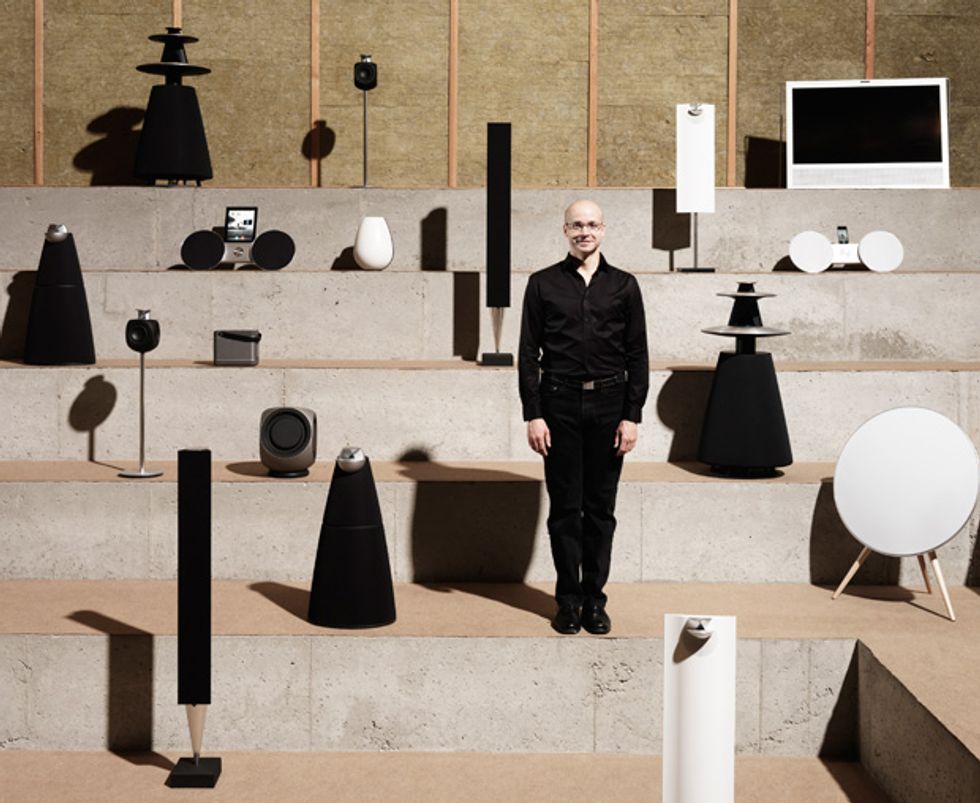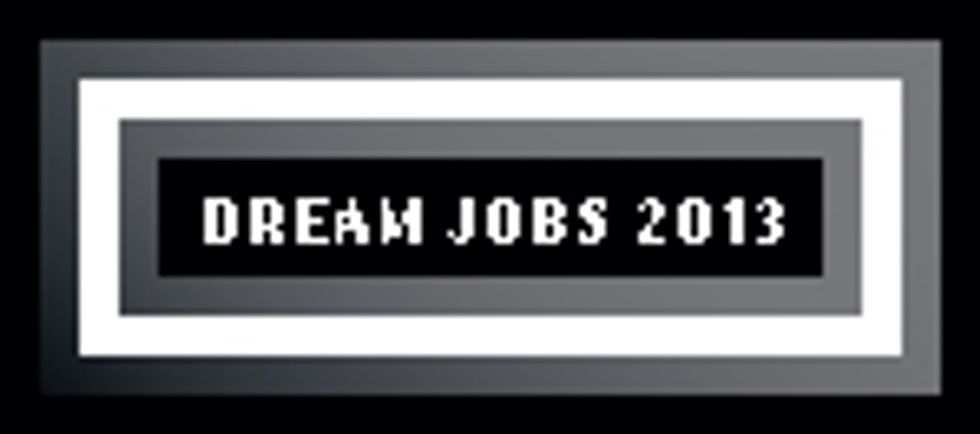Bang & Olufsen’s Geoff Martin Pursues the Perfect Sound
At Bang & Olufsen, Geoff Martin brings a musician’s sensibilities and an engineer’s precision to loudspeaker design

IEEE Member
Age 43
What he does Works with acoustic engineers to design high-end audio systems; contemplates the future of sound.
For whom Bang & Olufsen
Where he does it Struer, Denmark
Fun Factor Revels in discovering little-known surround-sound recordings, like Pink Floyd’s “Dark Side of the Moon.”
You love music, yet you’re also drawn to engineering, and you can’t decide which to pursue. What to do? Why, become a tonmeister, of course.
That’s what Geoff Martin did. No kidding: His official title is tonmeister of Bang & Olufsen, the Danish company that since 1925 has been showing the world that well-engineered audio and video equipment can also be beautiful.
The German word tonmeister, Martin explains, refers to someone who straddles music and engineering. “Once upon a time, if you wanted to do a recording, you needed to hire two people. One was a recording engineer, the geek who knew about acoustics, microphones, and electronics. The other was a producer who understands music and knew how to talk to the conductor and the musicians. A tonmeister is both of those people rolled into one.”At Bang & Olufsen, Martin works with engineers and designers to ensure that the components they produce sound really good. He’s the ears of B&O, in other words. And given the understandably high expectations of the company’s customers, who may be plunking down US $20 000 for a pair of loudspeakers, that’s a pretty hefty responsibility.
Martin spends a lot of time in a soundproofed, windowless, vibration-isolated listening room, equipped with various sets of B&O loudspeakers (commercial products as well as prototypes), a large but not gigantic flat-panel display, and some comfy chairs. When he closes the door, it seals with a satisfying thunk.
“It’s isolated from the rest of the world, which is lovely,” he says. “It also means that if I have to do some loud testing, I don’t annoy the people on the other side of the wall.” The room’s dimensions—which control reverberation times at various frequencies—are dictated by standard 60268-13 of the International Electrotechnical Commission. Sound designers use such standardized rooms to perform repeatable experiments in something that resembles an average living room. Martin’s listening room is useful when he and his colleagues are conducting research for publication, but it’s less helpful for designing actual products. “Most of our customers have living rooms that are much bigger than this—they have toilets that are bigger than this,” he says.
Which gets to one of the great difficulties in engineering the perfect loudspeaker: You have no control over where customers will put it or what they’ll play, but you have to come up with a product that sounds good nonetheless. “I have some of the strangest playlists in the world,” Martin says. For example? “Metallica followed immediately by Gregorian chant going straight over to Stravinsky going to Lady Gaga.”
Every B&O audio system has to play all that in all sorts of settings and always sound great. So during the design phase, each system is listened to and tweaked in a number of rooms, including Martin’s kitchen at home. Problems that turn up—a resonance at 3 kilohertz, say—can be digitally corrected by adding a filter to the unit’s digital signal processor.
Martin also spends time in B&O’s speaker-measurement room, otherwise known as “The Cube,” a 12- by 12- by 13-meter space where each speaker’s output in three dimensions is precisely measured. The attention to detail extends to the manufacturing of the components that go into each product, which is why the company has its own in-house aluminum shop. There, the far-out geometric shapes featured in its components are rolled, milled, shaped, dyed, or otherwise created. “It’s very easy to build a box speaker out of MDF [medium-density fiberboard] or plywood,” Martin explains. “But some of our speakers have such strange designs with weird curves, and those forms can’t really be done in wood.”
He’s not exaggerating. Bang & Olufsen’s Beolab 5, considered by many to be one of the best speakers money can buy, looks like a double-decker flying saucer wearing a hoop skirt.
In a way, Martin has spent his whole life preparing for this job.He grew up on the coast of Newfoundland, where there’s a strong folk-music tradition, and just about everyone he knew was musically inclined. “Back in those days if you couldn’t play an instrument, it was a bit weird,” he recalls.
As a boy, Martin took piano lessons and sang in church choirs. Then came a bachelor’s degree in music from Memorial University of Newfoundland and graduate work, also in music, at McGill University, in Montreal. But his Ph.D. thesis, titled “A Hybrid Model for Simulating Diffuse First Reflections in Two-Dimensional Synthetic Acoustic Environments,” was way more technical than most in his department. Throughout college and grad school, he earned money on the side as pipe organist, choir conductor, studio technician, and audio engineer.
In 2002, not long after Martin finished his doctorate, Søren Bech, an adjunct professor at McGill who worked for B&O, told him the company was looking for somebody with just his background. Martin had been thinking he wanted to work in Europe, so he applied, got an offer, and soon found himself relocating to the small town of Struer, in western Denmark, where the company is based.
Martin was hired to help design B&O’s first automotive sound system. The team was starting from scratch. “We didn’t even have a customer,” he says. Given Bang & Olufsen’s reputation in audio design, though, they knew it couldn’t be your run-of-the-mill car stereo system.
After developing a 1000-watt, 14-speaker prototype, B&O scored its first car: the Audi A8, the luxury automaker’s flagship. Then the real engineering started. “A car is a really bad place to put audio,” Martin says. “It’s noisy, none of the speakers are in the correct places, and none of the people are in the correct places. And hopefully, listening to the music is the second task—presumably you’re busy driving.”
On the other hand, he says, “I had almost surgical control over every [loudspeaker] driver, and I could put different filters, gains, and delays on each one.” He eventually added 285 digital filters to compensate for the deficiencies in the listening environment.
Problems cropped up in unexpected places. “It turned out the seat belt mechanism in the middle backseat vibrated at 83 hertz, and it was quite close to the subwoofer,” he says. “That caused me a lot of grief.” Toward the end, he was spending so much time at the Audi plant in Ingolstadt, Germany, that he moved there temporarily, just to avoid what would otherwise be a 12-hour drive.
The car company expected maybe 5 percent of its model year 2005 A8 buyers to shell out the extra €6000 [about US $8000 in current dollars] for the Bang & Olufsen system. In fact, four times as many did so. These days B&O’s automotive systems can also be found in Mercedes-AMGs, Aston Martins, and BMWs.
Martin no longer works on cars, nor does he just work on upcoming products. “About half of what I do is to look at how we will be listening to music in 10 years—not what we are going to put into the next product, but what do we need to start thinking about for the product after that or the one after that?”
One major draw of the job is that it affords Martin and his family an enviable quality of life. When he joined the company, his fiancée, who is also Canadian, was working in Ohio, and they debated over which country to settle in. What finally decided it? Denmark’s government-supported child care, health care, and free public education through college were far more attractive than what they’d get in the United States or Canada.
Danish corporate culture is also far more accommodating. “We work 8 to 4, four days a week, and on Fridays we work until 3,” he says. “Almost anything that doesn’t get done by 4 can wait until the next morning. The expectation is that you go home, spend time with your family, and enjoy your life.”
Which is not to suggest that Martin is a slacker. Indeed, he’s an energetic perfectionist. “I’m never satisfied with the final product. There’s never a point where I think, ah, that’s great.” There have been times, he says, when his colleagues thought a new model was ready to release, but his ears told him otherwise, and fixing the problem meant delaying the introduction. “I don’t do it often, because there are commercial implications to pulling the emergency brake,” he adds.
Clearly, Martin has found the perfect environment for his lifework—if you can really call it work. He doesn’t. “Being a tonmeister is not so much a job—it’s what you are.”
"Der Tonmeister," an abridged version of this article, appeared in the February print issue of IEEE Spectrum.

